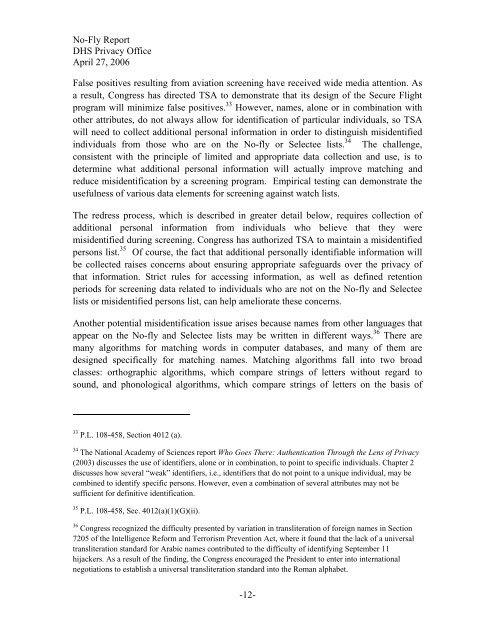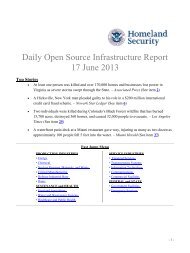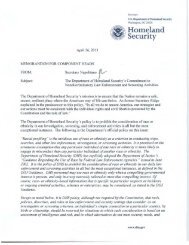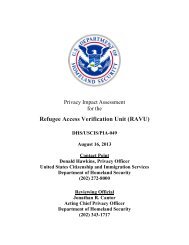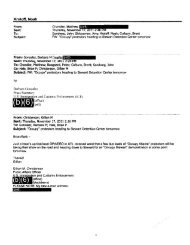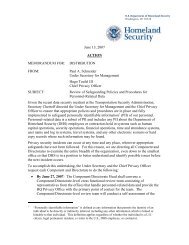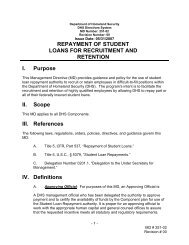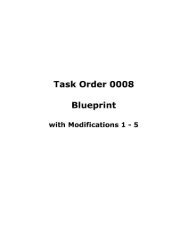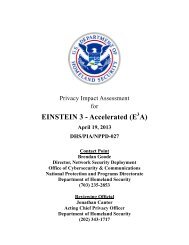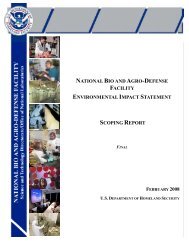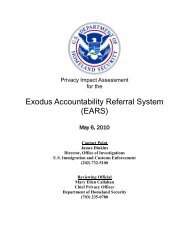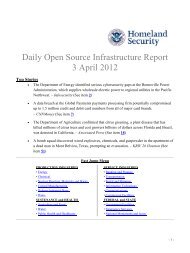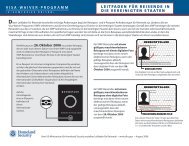Report: No Fly - Homeland Security
Report: No Fly - Homeland Security
Report: No Fly - Homeland Security
You also want an ePaper? Increase the reach of your titles
YUMPU automatically turns print PDFs into web optimized ePapers that Google loves.
<strong>No</strong>-<strong>Fly</strong> <strong>Report</strong><br />
DHS Privacy Office<br />
April 27, 2006<br />
False positives resulting from aviation screening have received wide media attention. As<br />
a result, Congress has directed TSA to demonstrate that its design of the Secure Flight<br />
program will minimize false positives. 33 However, names, alone or in combination with<br />
other attributes, do not always allow for identification of particular individuals, so TSA<br />
will need to collect additional personal information in order to distinguish misidentified<br />
individuals from those who are on the <strong>No</strong>-fly or Selectee lists. 34 The challenge,<br />
consistent with the principle of limited and appropriate data collection and use, is to<br />
determine what additional personal information will actually improve matching and<br />
reduce misidentification by a screening program. Empirical testing can demonstrate the<br />
usefulness of various data elements for screening against watch lists.<br />
The redress process, which is described in greater detail below, requires collection of<br />
additional personal information from individuals who believe that they were<br />
misidentified during screening. Congress has authorized TSA to maintain a misidentified<br />
persons list. 35 Of course, the fact that additional personally identifiable information will<br />
be collected raises concerns about ensuring appropriate safeguards over the privacy of<br />
that information. Strict rules for accessing information, as well as defined retention<br />
periods for screening data related to individuals who are not on the <strong>No</strong>-fly and Selectee<br />
lists or misidentified persons list, can help ameliorate these concerns.<br />
Another potential misidentification issue arises because names from other languages that<br />
appear on the <strong>No</strong>-fly and Selectee lists may be written in different ways. 36 There are<br />
many algorithms for matching words in computer databases, and many of them are<br />
designed specifically for matching names. Matching algorithms fall into two broad<br />
classes: orthographic algorithms, which compare strings of letters without regard to<br />
sound, and phonological algorithms, which compare strings of letters on the basis of<br />
33 P.L. 108-458, Section 4012 (a).<br />
34 The National Academy of Sciences report Who Goes There: Authentication Through the Lens of Privacy<br />
(2003) discusses the use of identifiers, alone or in combination, to point to specific individuals. Chapter 2<br />
discusses how several “weak” identifiers, i.e., identifiers that do not point to a unique individual, may be<br />
combined to identify specific persons. However, even a combination of several attributes may not be<br />
sufficient for definitive identification.<br />
35 P.L. 108-458, Sec. 4012(a)(1)(G)(ii).<br />
36 Congress recognized the difficulty presented by variation in transliteration of foreign names in Section<br />
7205 of the Intelligence Reform and Terrorism Prevention Act, where it found that the lack of a universal<br />
transliteration standard for Arabic names contributed to the difficulty of identifying September 11<br />
hijackers. As a result of the finding, the Congress encouraged the President to enter into international<br />
negotiations to establish a universal transliteration standard into the Roman alphabet.<br />
-12-


